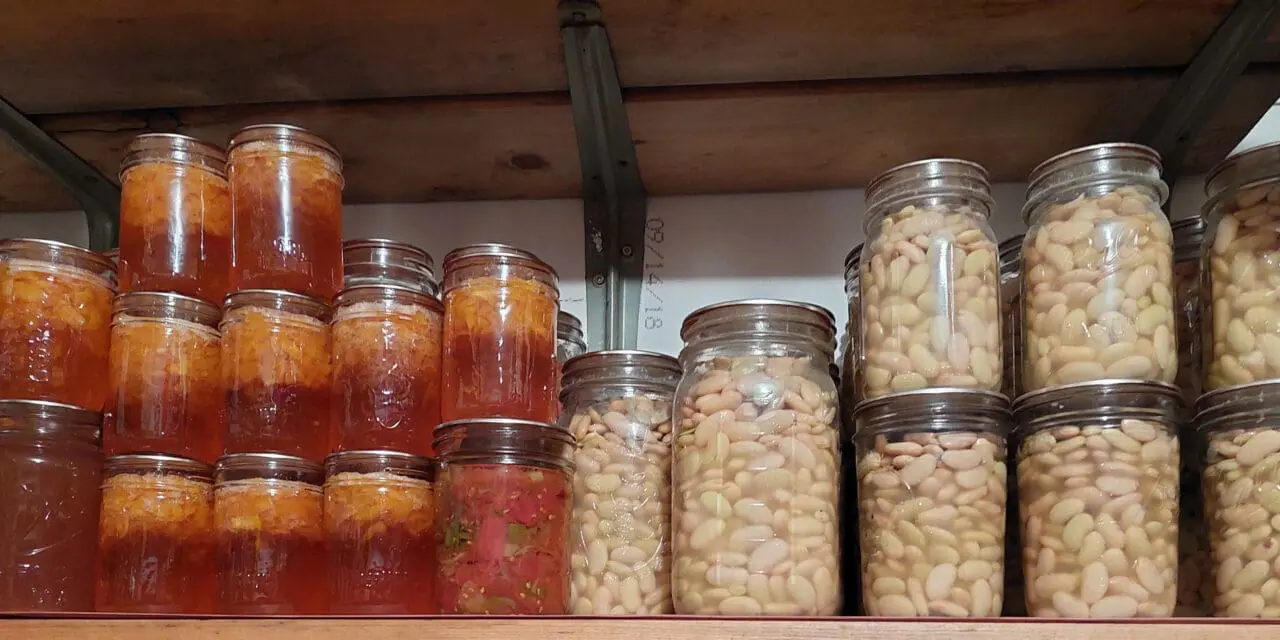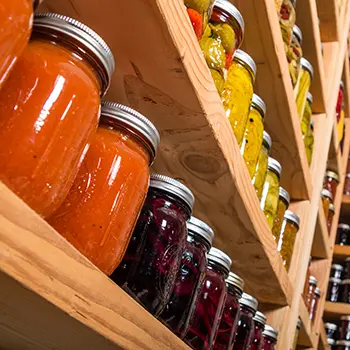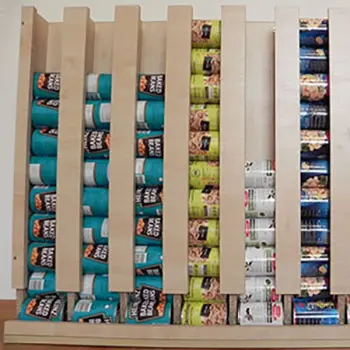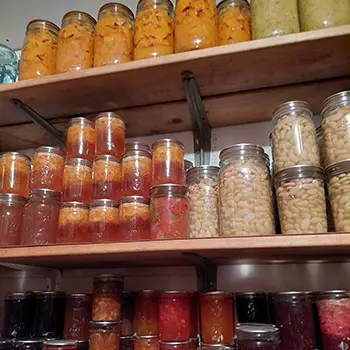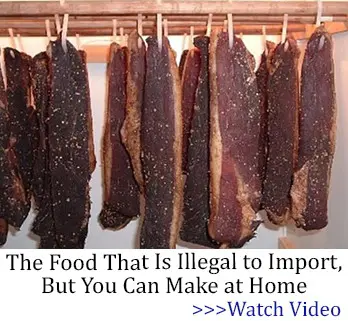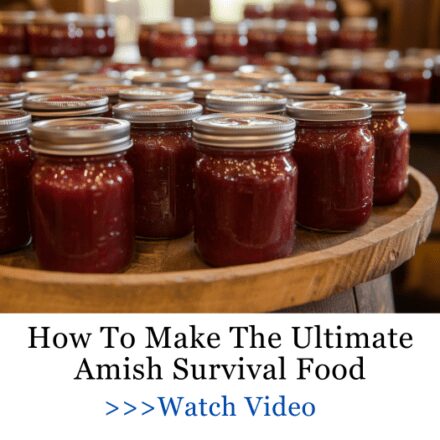Food stockpiling forms the backbone of homesteading and emergency preparedness. Yet, several critical errors can render even the most meticulously planned food storage strategy ineffective.
Today, we’ll delve into these mistakes, with a particular focus on the most devastating:
Improper Storage
When it comes to food stockpiling, nothing wreaks havoc quite like improper storage. It’s the silent killer of your carefully planned reserves, capable of turning a robust emergency food supply into a wasteland of spoiled goods.
But why is storage so crucial, and how can you get it right?
The Science of Food Preservation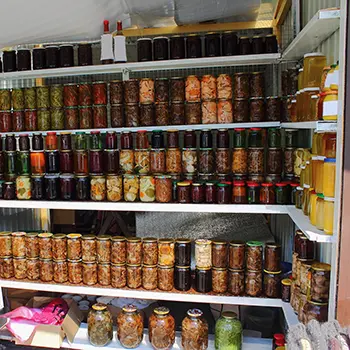
At its core, proper food storage is about controlling the environment. Every morsel in your stockpile is a complex ecosystem of nutrients, microorganisms, and chemical compounds.
Your job? To create conditions that preserve the good stuff while keeping the bad at bay.
Key factors in food preservation involve maintaining the right temperature, controlling humidity, minimizing light exposure, and managing oxygen levels. Each type of food responds differently to these factors.
For instance, while cool, dry conditions are ideal for grains, some fruits and vegetables require specific humidity levels to prevent shriveling or mold growth.
Related: 11 Food Storage Myths
Storage Guidelines for Common Stockpile Items
Here’s an expanded table outlining optimal storage conditions:
Food Type | Temperature | Humidity | Light | Oxygen | Storage Life | Notes |
Wheat Berries | 40-60°F (4-15°C) | <10% | Dark | Low | 20-30 years | Store in airtight containers with oxygen absorbers |
White Rice | 40-70°F (4-21°C) | <10% | Dark | Low | 25-30 years | Brown rice lasts only 3-6 months due to oil content |
Dried Beans | 40-70°F (4-21°C) | <10% | Dark | Low | 10-30 years | Older beans may require longer cooking times |
Canned Goods | 50-70°F (10-21°C) | N/A | Dark | N/A | 2-5 years | Avoid temperature fluctuations; check for bulging or rust |
Honey | 50-70°F (10-21°C) | N/A | Dark | N/A | Indefinite | Natural antimicrobial properties; may crystallize but still safe |
Dried Milk | <70°F (21°C) | <15% | Dark | Low | 2-10 years | Non-fat lasts longer than whole milk powder |
Pasta | <70°F (21°C) | <10% | Dark | Low | 20-30 years | Egg noodles have shorter shelf life (2-3 years) |
Salt | Room temp | <75% | N/A | N/A | Indefinite | Essential for food preservation and flavor |
Vegetable Oils | 70°F (21°C) | N/A | Dark | Low | 1-2 years | Rancidity is main concern; store in dark bottles |
Pro Tip: Invest in a good hygrometer to monitor humidity levels in your storage area. Plus aim for a relative humidity below 15% for most dry goods.
Remember, these are general guidelines. Always check specific storage instructions for each item in your stockpile.
Consequences of Incorrect Storage
Failing to provide proper storage conditions can result in several issues. Spoilage occurs when bacteria and molds thrive in warm, moist environments, leading to food becoming unsafe to eat.
Improper storage can also attract pests, with rodents and insects capable of destroying large quantities of food; a single mouse can contaminate much more food than it consumes. Additionally, even if food doesn’t visibly spoil, poor storage can lead to nutrient loss, where essential vitamins and minerals degrade, diminishing the nutritional value of your food supply.
Related: What We Learned Living on Our Food Storage for a Month
Other Common Food Stockpile Mistakes
While improper storage tops the list of food stockpile blunders, several other mistakes can jeopardize your hard work. Here are these pitfalls and how to avoid them.
Overreliance on a Single Food Source
Relying too heavily on one type of food can lead to nutritional deficiencies, food fatigue (yes, it’s real!), and increased vulnerability to issues like crop failures or recalls.
The solution is to diversify your stockpile by including a variety of grains like wheat, rice, and oats; legumes such as beans, lentils, and peas; a selection of fruits and vegetables in canned, dried, or freeze-dried forms; proteins like canned meats, dried eggs, and nuts; and essential fats from sources like oils and peanut butter.
This strategy not only ensures a balanced diet but also protects against potential problems with any single food source.
Neglecting Rotation
The “store it and forget it” mentality is a recipe for disaster. Without proper rotation, you risk consuming expired food, wasting money on spoiled goods, and losing track of your inventory.
The solution is to adopt the FIFO (First In, First Out) principle. This involves labeling all items with purchase and expiration dates, organizing shelves so older items are in front, and using newer purchases for daily consumption. Regularly checking expiration dates and rotating accordingly is essential.
To stay organized, consider using inventory management software or a simple spreadsheet to track your stockpile effectively.
Related: 23 Overlooked Survival Foods You Need To Add To Your Pantry
Ignoring Packaging
Original packaging isn’t just for show – it’s designed to protect food from the elements. Common packaging mistakes include removing food from factory packaging, using containers that aren’t food-grade, and failing to seal containers properly.
To preserve your food effectively, it’s best to keep items in their original packaging whenever possible. If repackaging is necessary, use food-grade containers along with oxygen absorbers to maintain freshness. Make sure all containers are tightly sealed to prevent contamination. For bulk storage, consider using Mylar bags with oxygen absorbers placed inside food-grade buckets for added protection.
Failing to Prepare for Pests
A single rodent or insect infestation can devastate your food supply. Don’t let your stockpile become an all-you-can-eat buffet for pests.
To prevent pest infestations in your food storage, it’s crucial to use airtight, pest-proof containers and keep storage areas clean and free of clutter. Natural deterrents, such as bay leaves or diatomaceous earth, can also be effective.
Regularly inspecting your stockpile for any signs of pests is essential. If an infestation is detected, isolate the affected items right away, identify the pest to determine the appropriate treatment, thoroughly clean the area, and reassess your storage methods to avoid future problems.
How to Build a Resilient Food Stockpile
Creating a robust, long-lasting food stockpile requires careful planning and ongoing management. Here are key strategies that have helped me succeed in this domain:
1. Start Smalling, & Grow Gradually
Starting with a short-term supply of 1-2 weeks and gradually expanding is a practical approach. It allows you to learn proper storage techniques without feeling overwhelmed, identify the foods your family regularly consumes and spread out the financial investment over time. This method helps in building a well-organized and sustainable stockpile that meets your needs efficiently.
Practical tip: Increase your stockpile by at least 5-10% each month until you reach your desired level of preparedness.
2. Store What You Eat, Eat What You Store
Focus on foods your family enjoys and knows how to prepare. This principle ensures your stockpile is used and rotated. Furthermore, it reduces waste from unfamiliar or disliked foods and provides comfort during stressful times.
Here’s a fun idea you should try out: create a “stockpile cookbook” with recipes using only stored ingredients to encourage regular use and familiarization.
Related: Pioneer Recipes Every Homesteader Should Learn
3. Learn Preservation Techniques
Expanding your food preservation skills can greatly improve your stockpile. Canning is perfect for preserving fruits, vegetables, and some meats, while dehydration works well for fruits, vegetables, and herbs.
Fermentation not only adds unique flavors but also provides probiotics. Freeze-drying is particularly effective, preserving nutritional value and extending shelf life dramatically. Properly canned foods can last between 1 and 5 years, and freeze-dried foods can remain in good condition for 25 to 30 years when stored properly.
4. Consider Non-Food Items
A comprehensive stockpile includes supportive items such as water filters and purification methods, and cooking fuel like propane and charcoal.
Consider adding a few more essentials to your stockpile, such as manual can openers, food preparation tools like grinders and solar ovens, and first aid supplies. With these additions, your stockpile will be well-equipped and comprehensive!
Checklist: Ensure you have at least one non-electric alternative for each essential food preparation method.
5. Create a Comprehensive Food Storage Plan
Document your goals, inventory, and rotation schedule.
Include short-term (1-3 months), medium-term (3-12 months), and long-term (1+ years) storage goals, calorie and nutritional targets based on family size and needs, as well as rotation and consumption schedule.
By avoiding all these common mistakes – particularly improper storage – and implementing best practices, you can create a resilient food supply that provides security and peace of mind.
Regularly review and update your storage practices, stay informed about new preservation techniques, and adapt your stockpile to meet your family’s changing needs.
How to Looter Proof Your Stockpile
A Step-by-Step Guide to Building Your Own Can Rotation System (Video)
10 Expired Foods That Will Help You Outlive A Crisis

